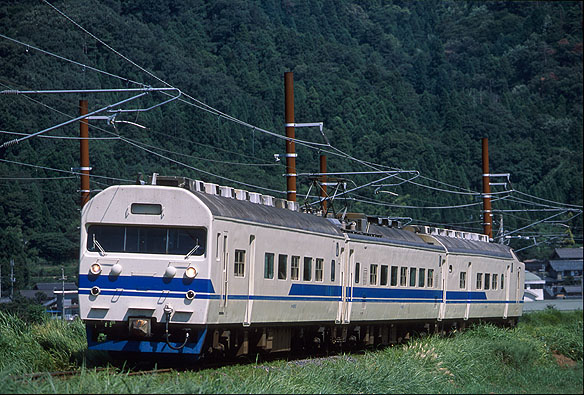Background and overview
Japanese National Railways remodeled surplus 583 series intercity dual
voltage AC/DC electric multiple unit (EMU) trains allocated at Mukomachi
depot in Kyoto into suburban EMU trains in order to replace and improve
the frequency of rural services in Kanazawa region and classified them
into 419 series. 15 three-car sets consisting of 2 powered vehicles and
1 trailer vehicles were delivered from 1984.
Car body
Their car body carried from former 583 series differ from original body
in having additional doorways, and introducing double-hung unit assembled
windows converted from some original fixed windows. Small windows fitted
on the body side for upper and middle bunks were filled with the plate
by welding. Lacked end vehicles caused by shorting the sets of 583 series
were filled up trailer intermediate vehicles, class sahane581, by jointing
the additional cab section and classified into class kuha418. Original
folding doors are remained and additional folding doors are fitted. Their
door operating equipment is TK7A, which can open/close manually to prevent
the passenger's saloon from being cold in winter. Their livery was dark
red with a horizontal white band below the windows.
Class kumoha419
An additional cab section is fitted where the section of toilets and washrooms
at the front of class mohane583 is cut off. A side window at the front
of the vehicle is also changed into an additional doorway. Nine air conditioners,
AU15, rated at 2,700kcal/h/unit and forced draught ventilators are fitted
on their roof. This vehicle is coupled on Ichinoseki side.
Class moha418
An additional folding door is fitted where the section of toilets and washrooms
on the front of class mohane582 is cut off. Four air conditioners, AU15,
rated at 2,700kcal/h/unit, forced draught ventilators are fitted on their
roof. Three air conditioners, AU41, rated at 4,000kcal/h are also fitted
on the floor.
Class kuha419
A side window toward end of trailer end vehicle, class kuhane581 is changed into additional doorways. Eight air conditioners, AU15, rated at 2,700kcal/h/unit and forced draught ventilators are fitted on their roof.
Class kuha418
An additional cab section is fitted where the section of a doorway at the
end of class sahane581 is cut off. Two side windows at the front and toward
end of the vehicle are also changed into additional doorways. Nine air
conditioners, AU15, rated at 2,700kcal/h/unit and forced draught ventilators
are fitted on their roof.
Bogies
Their powered bogie was remodeled from the powered bogie, DT32D, of former
581 series EMU and classified into DT32K. DT32K differs from DT32D in having
higher reduction gear ratio at 5.6. The trailer bogie was carried from
former 581 series EMU as it stands, employing airbags for the secondary
suspension, pedestal type journal supporting system, and the anti-rolling
stabilizer of the torsion bar. Their secondary airbag suspension is not
mounted to their body directly but mounted in the bogie unit. Their brake
rigging is a single tread brake for powered and double disk brake for trailer.
Traction unit and ancillary equipments
Their traction unit was carried from former 583 series EMU. Eight powerful
series-wound brushed DC traction motors, MT54B or MT54D, with a power output
of 120kW are controlled by the armature-resistance traction control system,
CS15E, fitted to powered end vehicles, class Kumoha419. Since the reduction
gear ratio at 3.5 of former 583 series EMU is not appropriate for use on
ordinary services, their traction gear unit was changed into another traction
gear unit transplanted from scrapped 101 series EMU used on commuter services.
Class moha418 vehicles are equipped with a traction rectifier, RS22, and
a traction transformer, TM20, to operate under both 50Hz and 60Hz under
their floor, and a diamond shaped current pickup, PS16H, for high voltage
and an air-blast circuit-breaker on their roof. Every end vehicle is equipped
with a current feeder voltage detector. Class kuha419 vehicles are equipped
with a motor generator, MH93B-DM55B, with a power output of 150kVA and
an air compressor, MH113A-C2000 in the equipment room behind the cab. On
the other hand, class kuha418-0 vehicles remodeled from trailer intermediate
vehicles are equipped with a motor generator, MH128D-DM85D, with a power
output of 110kVA and an air compressor, MH113B-C2000M under their floor.
They are transplanted from scrapped vehicles. 419 series adopt electromagnetic
straight pneumatic brake with the rheostatic brake.
Accommodation
Seating is arranged as mixture of longitudinal bench seating and transverse
seating bays with 1970mm seating pitch. Six transverse seating bays of
class moha418 vehicles, and eight of the others fitted at the centre of
the passenger cabin are carried from former 583 series EMU. Longitudinal
bench seating, hand straps, and hand rails are fitted where other original
transverse seating bays were removed. Original venetian blinds are fitted
for fixed windows and roller blinds for double-hung windows. Class kuha419
vehicles and class kuha418 vehicles are equipped with a Japanese style
toilet carried from 583 series. The other toilet is locked and the wash
rooms located across the aisle from the toilet are removed and the cover
is fitted where wash rooms are located.
Operations
419 series entered the rural revenue services of Hokuriku line in March,
1985. They were delivered to the Kosei line rural services in 1991.
Modification
Their livery was changed into light cream with a blue waistline and headline band running the length of each car below and above the windows in 1986. In 1988 to 1990, a refurbishment programme was commenced on 419 series excepting a few train sets. The fabric colour of their seating was changed in to orange. The inside windowpane of the double-glazing window, and venetian blinds were removed and sliding curtains were adopted.
Withdrawal
In 2006, 419 series started to be withdrawn caused by replacement with 521 series EMU and DC electrification of Hokuriku line between Maibara and Tsuruga, which had employed AC electrification. Eventually, they were completely withdrawn in March, 2011. |
|





